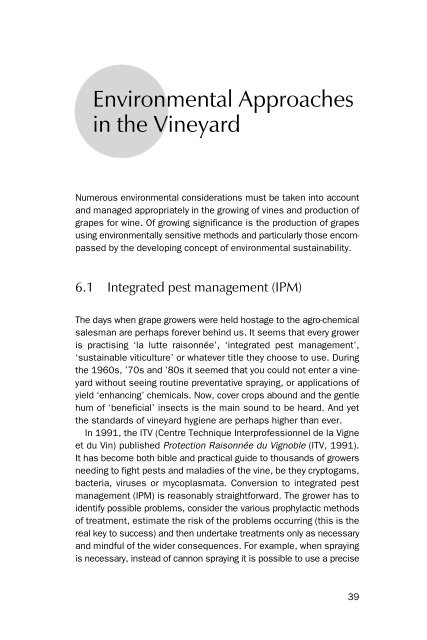Wine Production : Vine to Bottle - Vinum Vine
Wine Production : Vine to Bottle - Vinum Vine
Wine Production : Vine to Bottle - Vinum Vine
Create successful ePaper yourself
Turn your PDF publications into a flip-book with our unique Google optimized e-Paper software.
Environmental Approaches<br />
in the <strong>Vine</strong>yard<br />
Numerous environmental considerations must be taken in<strong>to</strong> account<br />
and managed appropriately in the growing of vines and production of<br />
grapes for wine. Of growing significance is the production of grapes<br />
using environmentally sensitive methods and particularly those encompassed<br />
by the developing concept of environmental sustainability.<br />
6.1 Integrated pest management (IPM)<br />
The days when grape growers were held hostage <strong>to</strong> the agro-chemical<br />
salesman are perhaps forever behind us. It seems that every grower<br />
is practising ‘la lutte raisonnée’, ‘integrated pest management’,<br />
‘sustainable viticulture’ or whatever title they choose <strong>to</strong> use. During<br />
the 1960s, ’70s and ’80s it seemed that you could not enter a vineyard<br />
without seeing routine preventative spraying, or applications of<br />
yield ‘enhancing’ chemicals. Now, cover crops abound and the gentle<br />
hum of ‘beneficial’ insects is the main sound <strong>to</strong> be heard. And yet<br />
the standards of vineyard hygiene are perhaps higher than ever.<br />
In 1991, the ITV (Centre Technique Interprofessionnel de la Vigne<br />
et du Vin) published Protection Raisonnée du Vignoble (ITV, 1991).<br />
It has become both bible and practical guide <strong>to</strong> thousands of growers<br />
needing <strong>to</strong> fight pests and maladies of the vine, be they cryp<strong>to</strong>gams,<br />
bacteria, viruses or mycoplasmata. Conversion <strong>to</strong> integrated pest<br />
management (IPM) is reasonably straightforward. The grower has <strong>to</strong><br />
identify possible problems, consider the various prophylactic methods<br />
of treatment, estimate the risk of the problems occurring (this is the<br />
real key <strong>to</strong> success) and then undertake treatments only as necessary<br />
and mindful of the wider consequences. For example, when spraying<br />
is necessary, instead of cannon spraying it is possible <strong>to</strong> use a precise<br />
39
















